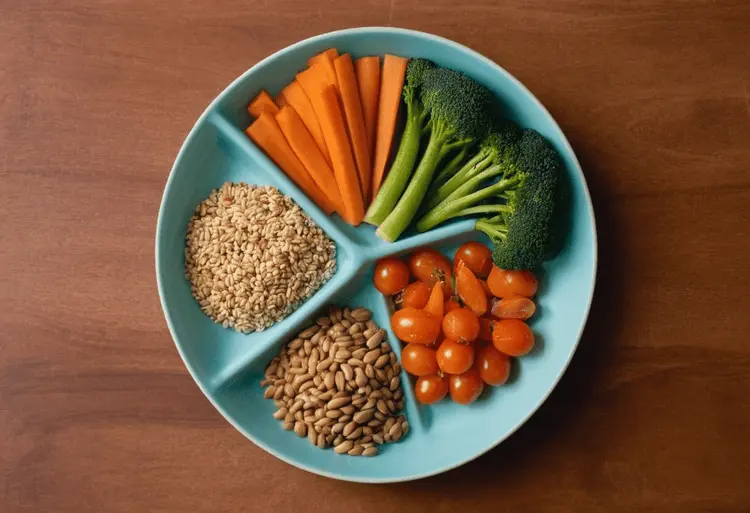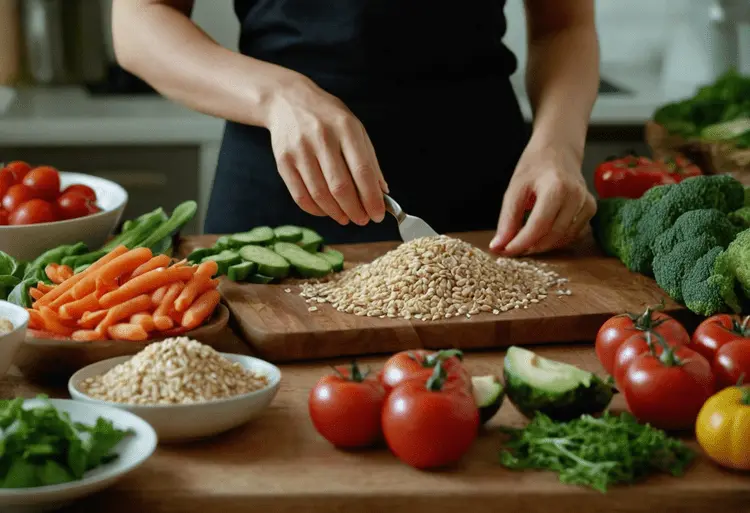Blood sugar control diet plans can feel overwhelming. Are you struggling to manage your blood sugar? Do spikes and crashes disrupt your energy and well-being?
Living with fluctuating blood sugar levels can be frustrating and even scary. You might feel confused by conflicting diet advice or overwhelmed by the restrictions of a diabetes-friendly diet.
The good news is, you can take control and achieve stable blood glucose levels. A blood sugar control diet is the foundation.
This ultimate guide empowers you with clear explanations, delicious meal ideas, and lifestyle strategies for long-term success. Discover how healthy eating for diabetes can be both satisfying and effective!
Blood Sugar Control Diet: The Essentials
- Prioritize non-starchy vegetables
- Choose whole grains over refined
- Include lean protein sources
- Add in healthy fats
- Limit sugar and processed foods
- Get regular exercise
Table of contents
Understanding Blood Sugar and Your Diet

The Blood Sugar Rollercoaster: What You Need to Know
Ever feel like your energy levels go haywire throughout the day? Hangry one minute, sluggish the next? That could be your blood sugar talking.
Understanding how blood sugar works is the first step towards designing a blood sugar control diet that helps you feel your best.
So, what is blood sugar exactly? It’s the main sugar found in your blood, coming from the food you eat. Think of it as your body’s fuel.
But just like too little fuel makes your car sputter, unstable blood sugar levels can wreak havoc on your energy, mood, and overall health.
Here’s where things get interesting: have you heard of the glycemic index (GI) and glycemic load (GL)? These measure how quickly foods raise your blood sugar.
A blood sugar control diet prioritizes foods with a lower GI and GL, leading to steadier energy levels and less risk for serious health problems.
Individuality is Key
There’s no one-size-fits-all blood sugar control diet. What works for your neighbor might not work for you. Factors like your current health, medications, and activity level all shape the perfect plan for you.
This is where healthcare professionals like doctors and registered dietitians become your best friends. They’ll help you personalize a diet that not only manages your blood sugar but also tastes good and fits your lifestyle.
Let me know – are you ready to take charge of your blood sugar? Share your story below, or tag us on social media!
Here are some things your personalized plan might consider:
- Age: Our bodies change as we get older.
- Activity Level: Fuel for workouts vs. a desk job is different.
- Medications: Some medications can impact blood sugar.
- ach meal.
- Healthy Fats: Don’t fear the fat! Good fats from avocados, nuts, seeds, and olive oil fight inflammation and boost satiety. A little goes a long way – think a drizzle of oil or a handful of nuts.
- Fiber-rich Wonders: Beans, lentils, berries – oh my! These superstars slow the release of sugar into your bloodstream. Is a sweet tooth your Achilles heel? Berries offer a touch
Ready to master those blood sugar spikes? Learn which delicious foods pack a punch in stabilizing your levels. Think of it as your secret weapon
Building Your Blood Sugar-Friendly Plate
The Star Players: Foods that Support Blood Sugar Control
Think of your plate as a stage, ready for a stellar performance! Let’s spotlight the foods that help you manage your blood sugar and keep those energy levels steady.
- Non-starchy Vegetables: These are your headliners! Think vibrant greens, crisp broccoli, juicy tomatoes – pile ’em high! Aim for half your plate overflowing with these colorful wonders.
- Lean Proteins: Power up your blood sugar control diet with lean protein sources. Think grilled chicken, fish, tofu, beans – they help you feel satisfied and keep blood sugar from spiking.
- Whole Grains: Go beyond the usual suspects! Quinoa, barley, and oats pack a fiber-filled punch, delivering sustained energy. But how much is ideal? Aim for about a fist-sized portion at each meal.
- Healthy Fats: Don’t fear the fat! Good fats from avocados, nuts, seeds, and olive oil fight inflammation and boost satiety. A little goes a long way – think a drizzle of oil or a handful of nuts.
- Fiber-rich Wonders: Beans, lentils, berries – oh my! These superstars slow the release of sugar into your bloodstream. Is a sweet tooth your Achilles heel? Berries offer a touch of sweetness without jeopardizing your blood sugar control.
Watch Your Intake: What to Limit or Avoid
Now, let’s talk about the foods that deserve a smaller role in your blood sugar control diet. It’s about moderation, not deprivation!
- Added Sugars: These sneaky saboteurs lurk in everything from soda to “healthy” granola bars. Always read those labels!
- Refined Grains: Think white bread, white rice, and sugary breakfast cereals. These cause quick blood sugar spikes and crashes. Instead, explore recipes with whole grains: [Anchor text: Healthy Eating Inspiration].
- Saturated and Trans Fats: Too much of these unhealthy fats can worsen heart health – a major concern for people with diabetes. Keep these to a minimum.
- Portion Sizes: Even the “good stuff” needs moderation. It’s easy to mindlessly overeat, so stay mindful of your portions.
Let me know – what’s your favorite blood sugar-friendly food? Share in the comments or tag us on social media!
Strategic Meal Planning

The Art of the Balanced Meal
Picture your dream plate – what does it look like? A hodgepodge of random foods, or a masterpiece of colors and textures? Building balanced meals is the key to a successful blood sugar control diet. It’s about finding the combinations that keep your blood sugar happy and your tastebuds excited!
So, what does a perfectly balanced plate entail? Let’s break it down:
- Non-starchy Veggies Rule: Aim for these to fill at least half of your plate. Think spinach, broccoli, carrots – the works!
- Protein Power: Lean options like fish, chicken, beans, or tofu offer sustained energy and help keep you satisfied.
- Whole Grains for the Win: Go for brown rice, quinoa, or whole wheat bread for long-lasting energy and fiber.
- Healthy Fats Fight Back: Add a drizzle of olive oil, a sprinkle of nuts, or a dollop of avocado for flavor and staying power.
Smart Snacking
Snacks: friend or foe? That depends on your choices! Smart snacking can help prevent blood sugar crashes. Think of snacks as mini-meals, focusing on:
- Protein + Fiber Dream Team: Try hard-boiled eggs with whole-grain crackers, a small apple with peanut butter, or plain Greek yogurt with berries.
FAQ: Can I still eat fruit with diabetes? Absolutely! Choose whole fruits over juice, and pair them with protein or healthy fats for balanced blood sugar.
Dining Out and Special Occasions
Sticking to your blood sugar control diet doesn’t mean missing out on life’s delicious moments. A little planning goes a long way!
- Restaurant Recon: Check out menus online beforehand. Many places offer healthier options or are happy to make modifications. Look for grilled or baked dishes, and ask about portion sizes.
- Become a Sauce Boss: Ask for sauces and dressings on the side so you can control the amount.
- Indulge Mindfully: It’s okay to have a treat! Choose something you truly love, savor every bite, and balance it with healthy choices throughout the rest of your day.
Enjoying food is part of the journey! Don’t stress, plan ahead, and you can navigate any dining scenario while championing your blood sugar goals.
Beyond the Plate: Lifestyle Factors That Matter
Your Blood Sugar Isn’t Just About Food
Think your blood sugar control diet is all about what’s on your plate? Think again! Your lifestyle plays a massive role in how your body handles those carbs and sugars. Let’s dive into the factors that matter.
Exercise: Your Blood Sugar’s Best Friend
Ever feel energized after a workout? There’s a reason for that! Exercise helps your muscles gobble up blood sugar for fuel and makes your body more sensitive to insulin. But what kind of exercise is best? And how much do you need?
- Types to try: Cardio (walking, swimming), strength training, or a mix!
- Aim for: At least 150 minutes of moderate-intensity exercise per week.
Sleep: The Reset Button Your Blood Sugar Needs
Skimping on sleep throws your hormones out of whack, and that includes the ones that regulate blood sugar. Not getting enough shut-eye can make you more insulin resistant. Yikes! So, how can you sleep better for the sake of your blood sugar?
- Create a relaxing bedtime routine: Wind down with a warm bath, some calming music, or light reading.
- Consistent sleep schedule: Even on weekends, try to stick to similar bedtimes and wake-up times.
- Optimize your sleep environment: Dark, cool, and quiet is ideal.
Stress: The Silent Saboteur
Feeling overwhelmed? Stress hormones like cortisol can send your blood sugar soaring. It’s your body’s ancient “fight or flight” response kicking in. But in modern life, chronic stress is a major problem for blood sugar management. How can you combat this?
- Relaxation techniques: Try [Reputable Diabetes-focused foundation] ([Anchor text: diabetes management tools]) for guided meditations or breathing exercises.
- Find what works for you: Yoga, spending time in nature, or simply listening to your favorite music can be powerful stress busters.
Putting It All Together

Your Blood Sugar Control Toolkit
Feeling overwhelmed? Don’t worry, you’ve got this! Let’s break down the key tools you’ll need to confidently manage your blood sugar control diet.
- Blood Sugar Monitoring: Is checking your blood sugar a part of your routine? Collaborate with your doctor to determine how often and what methods are best for you. This information is power!
- Adjusting Medications: Feeling like your medications need a tweak? Never adjust them on your own. Always consult with your healthcare provider for guidance on maintaining healthy blood sugar levels.
- Small Changes, Big Impact: Starting to feel like it’s too much? Remember, sustainable lifestyle shifts are the key to long-term blood sugar management. Focus on small, achievable changes that add up over time.
Resources and Support
You don’t have to do this alone! Reliable information and a supportive community make a world of difference.
- Tap into Expertise: Seek out credible resources like [Relevant government health organization] ([Anchor text: Reliable Blood Sugar Information]) for accurate and up-to-date guidance on managing your blood sugar.
- Find Your Friends: Explore the wealth of knowledge and encouragement within organizations like [Reputable diabetes-focused foundation] ([Anchor text: Diabetes Support Network]). Connection makes the journey easier!
Let’s keep the conversation going! What changes have made the biggest difference in your blood sugar levels? Have you found any helpful resources? Share your tips and experiences in the comments below, or find us on social media!
Discover the surprisingly sweet side of blood sugar control! After mastering the basics, explore the delicious foods that can be part of your diabetes-friendly diet…
Your Blood Sugar Control Questions, Answered
There’s no single “best” food. Focus on non-starchy vegetables, whole grains, lean protein, healthy fats, and fiber-rich options.
If your blood sugar is dangerously high, seek medical advice immediately. For moderate fluctuations, light exercise, water, and adjusting your diet can help.
Rather than a strict list, focus on limiting: sugary drinks, refined grains, trans fats, processed meats, full-fat dairy, very sweet fruits, and excessively large portions.
A healthy diet, regular exercise, stress management, and good sleep are key. Always work with your doctor, as medication might also be necessary.
No. Focus on whole-grain carbs, beans, and fruits for essential nutrients.
Use them very sparingly. They still affect your blood sugar levels.
Talk to your doctor. Alcohol can interact with medications and impact blood sugar.
Work with a registered dietitian or diabetes educator. They’ll create a personalized plan for you.
Yes! Monitor your blood sugar, energy levels, sleep, and weight.